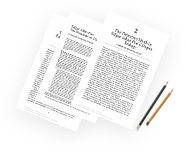Research two publicly traded companies and compare and contrast their methods of handling a significant change in their organizations. Analyze and write about images of change in those organizations in a Change Analysis Paper ‐ Images of Change (Milestone 1, include four references).
Topic Selection
Select your two companies that have undergone some type of fairly substantial change in the recent past. Find the company and the change information online using EBSCO or using another appropriate resource in the DeVry Library. Other ways to find information include utilizing Google, Yahoo Finance, or Reuters and looking up annual reports of companies that interest you. Often, reading the first sections of these reports (i.e., letters from CEOs) will give you ideas about changes they have gone through in the past year(s).
You will need to ensure the following.
a. Your companies are publicly traded so that their information will be easy to research and find.
b. Your change in the two companies are comparable (i.e., don’t compare a new CEO to a change in the human resources information system [HRIS]. Do compare two changes in chief information officer.
c. The changes happened in the recent past so that you will find sufficient online information about how they were handled, but not so recent that the information about the change results is still being researched and published.
Determining the Change (Milestone 2)
Select a diagnostic model that you can utilize to review aspects of change activities and actions that have been taken by the companies chosen. For this analysis, we are looking at the parts of the companies as well as their strategies, as surmised by your earlier research. It is acknowledged that this information will not be complete as you are looking at these companies as an outsider, but a thoroughly researched paper will give enough data to allow some well-defended assumptions on your part.
Here’s what to do.
1. Select one diagnostic model (i.e., 6-box, 7S, congruence, or one of the others) to apply to the two chosen companies. Choose the model that you feel best identifies and measures the relevant aspects of the organization’s performance.
2. Apply the data obtained in your research through an analysis of the appropriate chosen model. This will allow you to create a diagnosis of where each company is today (as per the criteria of the model).
3. Create a SWOT analysis for each of the two chosen companies’ change plans and programs, utilizing information obtained in the diagnosis (strengths, weaknesses, opportunities, and threats).
4. Compare the two company analyses to each other and offer your perspective (value judgment) of the effectiveness of the changes made to date in each case.
5. Identify potential areas of resistance that may occur and at least one strategy to respond to each. (This will most likely come from your weaknesses and threats section of your SWOT. If not, take another look at your SWOT.)
6. Make recommendations for further actions within the organizations and the rationale chosen for these recommendations.
7. Write the paper, including each of the above sections and analyses.
Grading Rubric
|
Category |
Description |
Total points |
|
Diagnostic Model |
Provide a comprehensive review of the change diagnostic model chosen that details the components included, as well as some background about the model itself through research from the author(s). |
15 |
|
Documentation and Formatting |
Paper is properly referenced according to APA guidelines with at least four references, properly cited and in-text citations included. |
10 |
|
Model Rationale |
Include your rationale defending why that particular model was selected. You can utilize a review of internal and external pressures that have affected the companies chosen. |
20 |
|
SWOT Analysis |
Create a SWOT analysis based on the above. Compare the two company analyses to each other and offer your perspective (value judgment) of the effectiveness of the changes made to date in each case. |
20 |
|
Areas of Resistance |
Address potential areas of resistance that were encountered or that you anticipate may be encountered and possible actions to minimize the negative effects of such resistance. |
20 |
|
Recommendations |
Include recommendations for further actions within the organizations and the rationale chosen for these recommendations. |
11 |
|
HRM Outcome B |
Employ an interdisciplinary perspective for strategic leadership, HR management and decision making so as to add value to the overall success of a business enterprise. |
4 |
|
Total Points |
A quality paper will meet or exceed all of the above requirements. |
100 |







